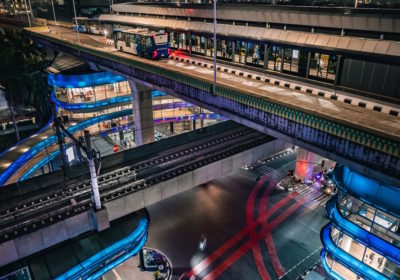As urban centers evolve into complex, data-driven ecosystems, bicycles are reclaiming their place as vital instruments of sustainable mobility. Yet, as cycling increases, so too does the urgency of addressing safety in low-light conditions. Advances in lighting technology have made impressive strides, but a new frontier is emerging—one defined by the integration of artificial intelligence. We explore how intelligent lighting systems are transforming bicycle safety, visibility, and urban connectivity in the era of smart cities

As the world embraces a new era of urban transformation, the bicycle has reemerged as a key player in the transition toward sustainable, inclusive, and human-centered mobility. Its ecological footprint is minimal, its infrastructure cost-effective, and its societal benefits substantial—from mitigating traffic congestion to fostering healthier lifestyles. In the context of smart cities, where digital technologies increasingly orchestrate urban life, the bicycle embodies a convergence of environmental responsibility and technological innovation. Yet, as cities modernize and cycling becomes more widespread, a persistent challenge remains: visibility and safety after dark. Statistically, nighttime cycling significantly increases the risk of serious accidents, with studies indicating a more than 50% increase in fatal or severe incidents during low-light conditions. A substantial portion of these accidents are directly attributable to inadequate bicycle lighting, a problem that demands not only technical innovation but also regulatory foresight and systemic integration.
The study “Energy-Efficient and Smart Bicycle Lamps: A Comprehensive Review”, built upon a corpus of over 23,000 technical and scientific sources, offers a sweeping overview of the current landscape and emerging frontiers in bicycle lighting technology. Its conclusions are unambiguous: while optical engineering and lighting performance have evolved rapidly—driven primarily by the proliferation of LEDs and advances in optical design—legislation and safety standards have struggled to keep pace. This regulatory lag creates a disconnect between technological capabilities and their real-world deployment, with significant implications for road safety, product interoperability, and the urban experience. The review makes clear that the future of bicycle lighting lies not merely in increasing brightness, but in designing intelligent, adaptive, and context-aware systems that integrate optics, electronics, and artificial intelligence.
From a historical perspective, the development of bicycle lighting mirrors the broader evolution of artificial illumination. In the 19th century, oil, gas, and acetylene lamps provided limited visibility and served primarily as beacons rather than true lighting systems. The 20th century saw a gradual progression, from incandescent and halogen bulbs to compact high-efficiency lighting units. The introduction of LED technology marked a transformative shift: light-emitting diodes brought exponential increases in luminous efficacy—surpassing 150 lm/W in modern models—along with enhanced durability, miniaturization, and resistance to environmental stress. Crucially, LEDs also opened the door to programmable lighting systems, laying the groundwork for intelligent beam control and digital integration.
However, the qualitative leap in lighting systems stems not only from hardware advancements but from a paradigm shift in design philosophy. No longer is illumination measured solely in lumens; what matters is how that light is distributed, controlled, and adapted to complex environments. Optical design now prioritizes the manipulation of the light beam through free-form reflectors, collimating lenses, and hybrid optics, enabling precise targeting of illuminated zones while minimizing glare. The photometric solid—the three-dimensional geometric distribution of luminous intensity—has become the true benchmark of lighting performance. Standards such as Germany’s StVZO §67, which mandate horizontal beam cut-offs to protect the vision of oncoming traffic, exemplify a regulatory approach grounded in real-world optical behavior. Achieving compliance requires meticulous segmentation of optical surfaces and sophisticated engineering that today reaches efficiency levels above 90%, a feat made possible by computational design and simulation tools.
It is at this intersection of optics, electronics, and software where artificial intelligence can play a pivotal role. The integration of AI into bicycle lighting systems introduces the possibility of real-time environmental analysis, predictive adaptation, and user-specific customization. Sensor arrays already collect data on speed, terrain, acceleration, ambient light, and motion patterns. With the application of AI algorithms—particularly those rooted in machine learning—these data streams can be transformed into actionable insights. A smart headlamp, for instance, could learn from repeated commute patterns to anticipate lighting needs at specific locations, adjust intensity dynamically based on weather or traffic conditions, and recognize hazardous intersections that require enhanced visibility. Furthermore, AI could optimize energy consumption by predicting battery usage and adjusting output accordingly, balancing safety with efficiency.
Advanced AI-powered systems could also contribute to broader goals of urban intelligence. Using computer vision and sensor fusion, a bicycle lighting system could detect not only environmental variables but also identify pedestrians, vehicles, or obstacles, and adjust beam patterns to maximize visibility without creating glare. Integrating these systems with urban traffic management platforms would allow for decentralized data-sharing, where bicycle units contribute to the city’s sensory infrastructure—reporting congestion, road surface conditions, or environmental hazards. Such a networked approach transforms the bicycle from a passive transport mode into an active agent of data-driven urban governance.
In terms of human-machine interaction, AI can enhance the usability and responsiveness of lighting systems. Voice-assisted controls, gesture recognition, and mobile integration offer intuitive ways for cyclists to interact with their lighting setup, while machine learning models can personalize settings based on rider behavior, preferred routes, and even physiological data, such as heart rate or fatigue level. As cycling continues to diversify demographically and functionally—commuters, couriers, children, the elderly—such adaptive systems will be essential in ensuring inclusive safety standards.
Nonetheless, the adoption of AI in bicycle lighting also presents new challenges, particularly in terms of energy demands, system complexity, and cybersecurity. Intelligent systems require computational resources and power, making efficient energy management critical. Hybrid power solutions, such as kinetic energy harvesters or micro-turbines integrated into the drivetrain, offer promising pathways, but must be matched with low-power AI architectures capable of running edge inference models. Moreover, connectivity exposes systems to vulnerabilities; as lighting becomes part of the Internet of Things (IoT), protecting user data and ensuring system integrity will be vital to maintaining trust and reliability.
From a regulatory standpoint, there is a pressing need for international harmonization of standards that reflect the current state of technology. The divergence between high-performance systems and outdated legal frameworks not only hampers innovation but creates safety risks. A more intelligent regulatory environment—one that embraces performance-based standards, photometric disclosure, and system interoperability—will be necessary to fully unlock the potential of AI-enhanced lighting. Germany’s regulatory leadership, while commendable, should serve as a blueprint for broader international alignment.
In conclusion, the evolution of bicycle lighting is emblematic of the broader transformation of urban mobility through intelligent technologies. Lighting has moved beyond its utilitarian origins to become an integral component of a cyclist’s safety, perception, and connectivity within the city. With the integration of artificial intelligence, lighting systems are poised to become truly adaptive, predictive, and communicative—capable not only of illuminating the road ahead but of interacting intelligently with both rider and environment. In the smart cities of the future, the bicycle light will not merely make cyclists visible; it will make them visible as data-rich, intelligent, and responsive nodes in an interconnected urban ecosystem.



